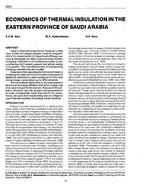Description
Using a detached single-family house as a base case, a load and energy analysis computer program, DOE-2.1A, devised by the US Department of Energy, was used to investigate the effect of incorporating resistive insulating materials in the building envelope on air conditioning (A/C) system capacity and annual energy consumption. The cost-effectiveness of incorporating insulating materials was also studied. It was found that upgrading the thermal performance (insulating the walls and roofs) of the base house leads to significant reductions in peak cooling (up to 34%) and annual energy consumption (up to 49%) demands. The cost analysis results show a very quick payback period and an energy-efficient home at low energy cost and a clear net gain for the end user. Because of the subsidy in electricity cost, the net gain to the government is an order of magnitude higher than that for the owner. Hence, the gains from implementing laws for obligatory use of thermal insulation in buildings will be immense.
KEYWORDS: Saudi Arabia, economics, thermal insulation, housing, domestic, dwellings, computer programs, air conditioning, calculating, heat flow, measuring, insulating materials, walls, roofs, energy consumption, insulated housing, building regulations.
Citation: ASHRAE Transactions, vol.96, pt. 1, Atlanta, 1990
Product Details
- Published:
- 1990
- Number of Pages:
- 8
- File Size:
- 1 file , 900 KB
- Product Code(s):
- D-18354




